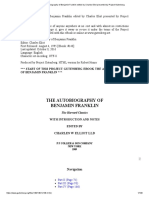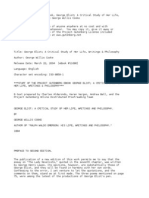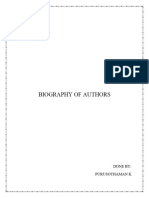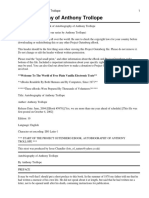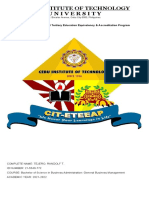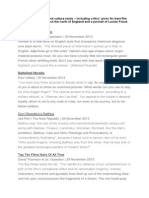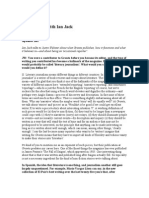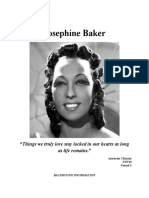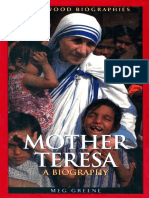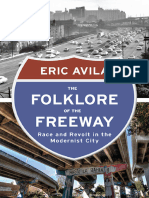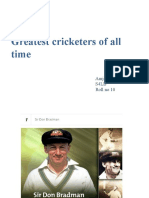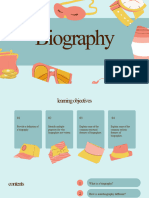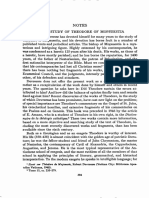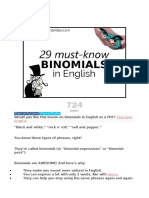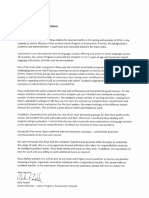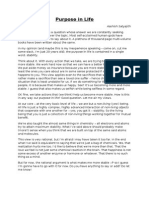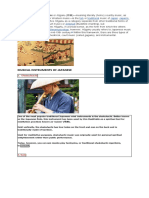Biography
A biography, or simply bio, is a detailed description of a person's life. It involves more than just basic
facts like education, work, relationships, and death; it portrays a person's experience of these life events.
Biography presents a subject's life story, highlighting various aspects of their life, including intimate
details of experience, and may include an analysis of the subject's personality.
Biographical works are usually non-fiction, but fiction can also be used to portray a person's life. One in-
depth form of biographical coverage is called legacy writing. Works in diverse media, from literature to
film, form the genre known as biography.
A biography is simply the story of a real person's life. It could be about a person who is still alive,
someone who lived centuries ago, someone who is globally famous, an unsung hero forgotten by history,
or even a unique group of people.
Biography, form of literature, commonly considered nonfictional, the subject of which is the life of an
individual. One of the oldest forms of literary expression, it seeks to re-create in words the life of a
human being—as understood from the historical or personal perspective of the author—by drawing
upon all available evidence, including that retained in memory as well as written, oral, and pictorial
material.
Aspects
Historical - Biography, once seen as a subset of history, is now recognized as a distinct literary
form. While history deals in generalizations, biography focuses on individual lives. Both share a
concern for the past and involve the pursuit, evaluation, and selection of sources. Biographers of
deceased individuals navigate challenges such as a lack of sources, while those writing about
recently deceased subjects face an abundance of materials. The key responsibility is to
authenticate collected materials rigorously. When the subject is alive, the biographer must
scrutinize their perspective against multiple sources.
Psychological - Biography goes beyond a mere chronological string of facts, aiming to uncover
the motives behind a person's actions and reveal their personality. Biographers face a trade-off:
those who knew their subject in life bring personal impressions but may be influenced by
emotions, while those relying solely on written evidence offer greater objectivity but lack the
insight from a personal relationship. In the 20th century, biographers embraced psychological
theories, with varying degrees of application. Some used tools like Freudian analysis, Jungian
archetypes, and Oedipus complex interpretations, while others, especially in scholarly works,
ignored psychological methods. The trend post-World War I has leaned towards a discreet use of
psychological approaches, with some biographers skillfully incorporating them, such as Erik
Erikson and Leon Edel, while others explore their own connection with the subject before
delving into the biography.
� Ethical - The biographer, especially when dealing with contemporaries, often grapples with an
ethical dilemma: how much of the truth, as they've uncovered it, should be revealed in print?
This age-old and unanswerable question has been central to discussions on biographical
literature since the late 18th century. Notably, James Boswell faced accusations of slandering
Samuel Johnson upon the publication of the Life of Samuel Johnson, and more recently, Lord
Moran's Winston Churchill biography drew similar criticism for using Boswellian techniques. In
the U.S., William Manchester's Death of a President stirred controversy, framed as "the public's
right to know." However, for the biographer, the challenge lies in balancing the obligation to
preserve historical truth against the potential personal anguish inflicted on others. With no
agreed-upon standard of "biographical morality," each biographer must navigate their own path.
In the 20th century, this task is further complicated by restricted access to documents,
particularly from custodians of papers belonging to significant individuals, especially national
political figures.
Aesthetic - Biography, while related to history in its search for facts and its responsibility to truth,
is truly a branch of literature because it seeks to elicit from facts, by selection and design, the
illusion of a life actually being lived. Within the bounds of given data, the biographer seeks to
transform plain information into illumination. If he invents or suppresses material in order to
create an effect, he fails truth; if he is content to recount facts, he fails art. This tension, between
the requirements of authenticity and the necessity for an imaginative ordering of materials to
achieve lifelikeness, is perhaps best exemplified in the biographical problem of time. On the one
hand, the biographer seeks to portray the unfolding of a life with all its cross-currents of
interests, changing emotional states, events; yet in order to avoid reproducing the confusion and
clutter of actual daily existence, he must interrupt the flow of diurnal time and group his
materials so as to reveal traits of personality, grand themes of experience, and the actions and
attitudes leading to moments of high decision. His achievement as a biographical artist will be
measured, in great part, by his ability to suggest the sweep of chronology and yet to highlight
the major patterns of behaviour that give a life its shape and meaning.
Kinds - Biographies are difficult to classify. It is easily recognizable that there are many kinds of
lifewriting, but one kind can easily shade into another; no standard basis for classification has yet
been developed. A fundamental division offers, however, a useful preliminary view: biographies
written from personal knowledge of the subject and those written from research.
Firsthand knowledge - Biographies often emerge from a vital connection between the
biographer and the subject, blending the writer's desire to preserve a person's life journey with
a recognition of their unique qualifications for the task. This type of biography, seen across
diverse cultures and historical periods, is rooted in direct observation and access to personal
papers. Known as "source biography," it relies on original materials and intimate papers of the
subject. Examples include Einhard's "Life of Charlemagne" and Thomas Moore's "Letters and
Journals of Lord Byron." Masterpieces in this genre, stemming from living relationships, include
Tacitus's Agricola, William Roper's life of Sir Thomas More, and James Boswell's acclaimed Life of
Samuel Johnson.
� Research - Biographies that are the result of research rather than firsthand knowledge present a
rather bewildering array of forms. First, however, there should be mentioned two special kinds
of biographical activity.
Informative biography - This, the first category, is the most objective and is sometimes called
“accumulative” biography. The author of such a work, avoiding all forms of interpretation except
selection—for selection, even in the most comprehensive accumulation, is inevitable—seeks to
unfold a life by presenting, usually in chronological order, the paper remains, the evidences,
relating to that life. This biographer takes no risks but, in turn, seldom wins much critical acclaim:
his work is likely to become a prime source for biographers who follow him. During the 19th
century, the Life of Milton: Narrated in Connection with the Political, Ecclesiastical, and Literary
History of his Time (7 vol., 1859–94), by David Masson, and Abraham Lincoln: A History (10 vol.,
1890), by John G. Nicolay and John Hay, offer representative samples. In the 20th century such
works as Edward Nehls’s, D.H. Lawrence: A Composite Biography (1957–59) and David Alec
Wilson’s collection of the life records of Thomas Carlyle (1923–29), in six volumes, continue the
traditions of this kind of life writing.
Critical biography - The second category of biography, scholarly and critical, differs from the first
by providing a genuine presentation of a person's life. These works are meticulously researched,
with thorough documentation in notes, appendixes, and bibliographies. They avoid fictional
elements, presenting the life in chronological order. While some may lack broad appeal, the
most skillful ones, like Leslie Marchand's Byron or Dumas Malone's Jefferson and His Time,
effectively convey a personality in action. Critical biography evaluates both the subject's life and
works, sometimes intertwining them or dedicating separate chapters to each. Despite some
failures, notable examples include Arthur S. Link's Wilson, Richard Ellmann's James Joyce, and
Edgar Johnson's Charles Dickens.
Standard biography - This third, and central, category of biography, balanced between the
objective and the subjective, represents the mainstream of biographical literature, the practice
of biography as an art. From antiquity until the present—within the limits of the psychological
awareness of the particular age and the availability of materials—this kind of biographical
literature has had as its objective what Sir Edmund Gosse called “the faithful portrait of a soul in
its adventures through life.” It seeks to transform, by literary methods that do not distort or
falsify, the truthful record of fact into the truthful effect of a life being lived. Such biography
ranges in style and method from George Cavendish’s 16th-century life of Cardinal Wolsey, Roger
North’s late-17th-century lives of his three brothers, and Boswell’s life of Johnson to modern
works like Lord David Cecil’s Melbourne, Garrett Mattingly’s Catherine of Aragon, Andrew
Turnbull’s Scott Fitzgerald, and Leon Edel’s Henry James.
� Interpretative biography - The fourth category of life writing is subjective and lacks a
standardized identity. Catherine Drinker Bowen's earlier works, such as "Beloved Friend" (1937)
on Tchaikovsky and "Yankee from Olympus" (1944) on Oliver Wendell Holmes, exemplify this
style. Bowen crafts a vivid narrative by interpreting sources with insight gained from rigorous
research. While she doesn't invent materials, she freely manipulates them to unfold her
subject's life vividly. Many interpretative biographies, like those by Frank Harris and Hesketh
Pearson, approach fictionalization in their flexible use of materials.
Fictionalized biography - The books in this fifth category belong to biographical literature only by
courtesy. Materials are freely invented, scenes and conversations are imagined; unlike the
previous category, this class often depends almost entirely upon secondary sources and cursory
research. Its authors, well represented on the paperback shelves, have created a hybrid form
designed to mate the appeal of the novel with a vague claim to authenticity. This form is
exemplified by writers such as Irving Stone, in his Lust for Life (on Vincent van Gogh) and The
Agony and the Ecstasy (on Michelangelo). Whereas the compiler of biographical information (the
first category) risks no involvement, the fictionalizer admits no limit to it.
Fiction presented as biography - The sixth and final category is outright fiction, the novel written
as biography or autobiography. It has enjoyed brilliant successes. Such works do not masquerade
as lives; rather, they imaginatively take the place of biography where perhaps there can be no
genuine life writing for lack of materials. Among the most highly regarded examples of this genre
are, in the guise of autobiography, Robert Graves’s books on the Roman emperor Claudius, I,
Claudius and Claudius the God and His Wife Messalina; Mary Renault’s The King Must Die on the
legendary hero Theseus; and Marguerite Yourcenar’s Memoirs of Hadrian. The diary form of
autobiography was amusingly used by George and Weedon Grossmith to tell the trials and
tribulations of their fictional character Charles Pooter in The Diary of a Nobody (1892). In the
form of biography this category includes Graves’s Count Belisarius and Hope Muntz’s Golden
Warrior (on Harold II, vanquished at the Battle of Hastings, 1066). Some novels-as-biography,
using fictional names, are designed to evoke rather than re-create an actual life, such as W.
Somerset Maugham’s Moon and Sixpence (Paul Gauguin) and Cakes and Ale (Thomas Hardy) and
Robert Penn Warren’s All the King’s Men (Huey Long).
Special purpose biography - In addition to these six main categories, there exists a large class of
works that might be denominated “special-purpose” biography. In these works the art of
biography has become the servant of other interests. They include potboilers (written as
propaganda or as a scandalous exposé) and “as-told-to” narratives (often popular in
newspapers) designed to publicize a celebrity. This category includes also “campaign
biographies” aimed at forwarding the cause of a political candidate (Nathaniel Hawthorne’s Life
of Franklin Pierce [1852] being an early example); the weighty commemorative volume, not
infrequently commissioned by the widow (which, particularly in Victorian times, has usually
enshrouded the subject in monotonous eulogy); and pious works that are properly called
hagiography, or lives of holy men, written to edify the reader.
� Informal biography - Autobiography, like biography, manifests a wide variety of forms, beginning
with the intimate writings made during a life that were not intended (or apparently not
intended) for publication. Whatever its form or time, however, autobiography has helped define
a nation’s citizens and political ambitions. The form is crucial to not only how an individual meets
the challenge of stating “I am” but how a nation and a historical period do so.
Formal autobiography - Autobiography, a unique form of biographical truth, captures a life
reshaped by recollection, marked by conscious and unconscious omissions and distortions.
Graham Greene aptly calls an autobiography "a sort of life." Autobiographers reveal what they
wish or feel compelled to share at a given moment, with recollections evolving over time.
Despite the advantage of exclusive information, autobiographers grapple with establishing a
balanced perspective. Autobiographical literature in antiquity and the Middle Ages is scarce,
with notable examples emerging in the Renaissance, starting with Margery Kempe's dictated
account in 15th-century England. Enea Silvio Piccolomini's autobiography, "Commentarii,"
written after becoming Pope Pius II in 1458, is considered one of the genre's early masterpieces.
Autobiography flourished from the Renaissance to the Age of Enlightenment, featuring works by
Gironimo Cardano, Benvenuto Cellini, Lord Herbert of Cherbury, and Colley Cibber. Notable
examples from the Enlightenment include Edward Gibbon's urbane narrative, Benjamin
Franklin's success story, and J.-J. Rousseau's introspective "Confessions." The term
"autobiography" first appeared in print in 1797, coinciding with the end of the 18th century.
Specialized forms of autobiography - Autobiographies can be loosely categorized into four
groups: thematic, religious, intellectual, and fictionalized. Thematic autobiographies, exemplified
by Adolf Hitler's Mein Kampf, Edward Bok's The Americanization of Edward Bok, and Richard
Wright's Native Son, serve diverse purposes. Religious autobiography includes notable works like
the Confessions of St. Augustine, Peter Abelard's Historia Calamitatum, Thomas Carlyle's Sartor
Resartus, and John Henry Cardinal Newman's Apologia. The 19th and early 20th centuries
witnessed the rise of intellectual autobiographies, such as John S. Mill's analytical account and
Henry Adams' quest in The Education of Henry Adams. Intellectual variations are seen in
Edmund Gosse's Father and Son and George Moore's Hail and Farewell. Lastly, akin to a novel as
biography, there are autobiographies thinly veiled as novels, including Samuel Butler's Way of All
Flesh, James Joyce's Portrait of the Artist as a Young Man, George Santayana's Last Puritan, and
the extensive novels of Thomas Wolfe like Look Homeward, Angel and Of Time and the River.






